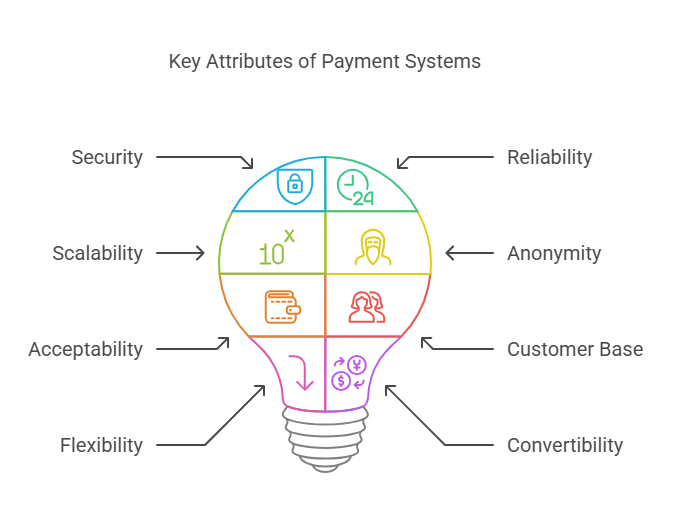Attributes of a well functioning payment system
A well-functioning payment system is crucial for a modern economy, especially with the rise of digital transactions. It needs to be robust, secure, and user-friendly. Here's a breakdown of the key attributes:
 1. Security:
1. Security:
- Explanation: Payment systems handle sensitive financial information, making them prime targets for fraud. Robust security measures are essential to protect against unauthorized access, data breaches, and manipulation.
-
Key Aspects:
- Encryption to safeguard data during transmission.
- Authentication to verify the identity of users.
- Fraud detection and prevention mechanisms.
- Regular security audits and updates.
2. Reliability:
- Explanation: The payment system must be consistently available and operational. Downtime can disrupt businesses and cause significant economic losses.
-
Key Aspects:
- Redundancy to prevent single points of failure.
- Robust infrastructure with high uptime.
- Disaster recovery plans.
- Monitoring and maintenance to ensure continuous operation.
3. Scalability:
- Explanation: The system should be able to handle increasing transaction volumes and user growth without performance degradation.
-
Key Aspects:
- Distributed architecture to handle load.
- Efficient processing and storage capabilities.
- Ability to adapt to changing demands.
- The system must be able to add more servers as the load increases.
4. Anonymity (or Privacy):
- Explanation: Users should have control over their financial data and be able to conduct transactions with a degree of privacy. Balancing anonymity with regulatory requirements (e.g., anti-money laundering) is crucial.
-
Key Aspects:
- Data minimization and encryption.
- Control over data sharing.
- Protection against unauthorized tracking.
- Different levels of anonymity might be required, depending on the type of transaction.
5. Acceptability:
- Explanation: The payment system must be widely accepted by merchants and users to facilitate seamless transactions.
-
Key Aspects:
- Interoperability with different systems and platforms.
- Standardized protocols and formats.
- Global or regional reach.
- It is vital that all user on all servers can transact with each other.
6. Customer Base:
- Explanation: A large user base increases the value and utility of the payment system for both merchants and consumers.
-
Key Aspects:
- Ease of onboarding and use.
- Incentives for adoption.
- Marketing and promotion.
- The more people that use the system, the more valuable it becomes.
7. Flexibility:
- Explanation: The system should support a variety of payment methods and options to meet diverse user needs.
-
Key Aspects:
- Support for different payment instruments (e.g., credit cards, digital wallets, bank transfers).
- Options for different transaction types (e.g., micropayments, recurring payments).
- Customizable payment settings.
- The system should accommodate many payment types such as checks, electronic money, and credit.
8. Convertibility:
- Explanation: Users should be able to easily convert between different payment instruments and currencies.
-
Key Aspects:
- Seamless currency exchange.
- Interoperability between different payment systems.
- Transparent conversion rates.
- Users need to be able to use the payment method that best suits their needs, and easily change between payment types.
9. Efficiency:
- Explanation: The system should be cost-effective and provide fast transaction processing.
-
Key Aspects:
- Low transaction fees.
- Fast settlement times.
- Minimal processing overhead.
- Micropayments should be able to be processed without high fees.
10. Ease of Integration:
- Explanation: The system should be easy to integrate with existing applications and platforms.
-
Key Aspects:
- Standardized APIs and documentation.
- Support for common programming languages and frameworks.
- Plug-and-play integration options.
- Using standard API's makes it easier for developers to impliment the payment system.

No Comments